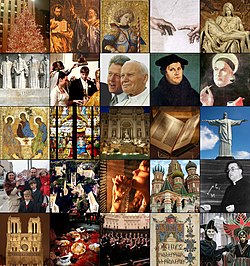Liturgical music
The examples and perspective in this article deal primarily with Catholic church and does not discuss other denominations much if at all). Plus, even for the Cath. church, it fails to give much historic context and seems only concerned with such music since Vatican II... and do not represent a worldwide view of the subject. (October 2021) |
| Part of a series on |
| Christian culture |
|---|
 |
| Christianity portal |
Liturgical music originated as a part of
The qualities that create the distinctive character of liturgical music are based on the notion that liturgical music is conceived and composed according to the norms and needs of the various historic liturgies of particular denominations.
Roman Catholic church music

The interest taken by the Catholic Church in music is shown not only by practitioners, but also by numerous enactments and regulations calculated to foster music worthy of Divine service.
While there have been historic disputes within the church where elaborate music has been under criticism, there are many period works by Orlandus de
Prior to the
In 1963, the Constitution on the Sacred Liturgy (Sacrosanctum Concilium) of the Second Vatican Council directed that "bishops and other pastors of souls must be at pains to ensure that, whenever the sacred action is to be celebrated with song, the whole body of the faithful may be able to contribute that active participation which is rightly theirs, as laid down in Art. 28 and 30", which articles say: "To promote active participation, the people should be encouraged to take part by means of acclamations, responses, psalmody, antiphons, and songs".[3] Full and active participation of the people is a recurring theme in the Vatican II document.[4] To achieve this fulsome congregational participation, great restraint in introducing new hymns has proven most helpful.[5]
Anglican church music
While music is important within many types of Anglican service, it forms a prominent part of choral Mattins and Evensong.
See also
- Christian liturgy
- Ephrem the Syrian
- Contemporary Catholic liturgical music
- Church music
- Christian music
- Religious music
References
- ^ a b c
 One or more of the preceding sentences incorporates text from a publication now in the public domain: Gietmann, Gerhard (1911). "Ecclesiastical Music". In Herbermann, Charles (ed.). Catholic Encyclopedia. Vol. 10. New York: Robert Appleton Company. Retrieved 2007-05-17.
One or more of the preceding sentences incorporates text from a publication now in the public domain: Gietmann, Gerhard (1911). "Ecclesiastical Music". In Herbermann, Charles (ed.). Catholic Encyclopedia. Vol. 10. New York: Robert Appleton Company. Retrieved 2007-05-17.
- ^ Musicae sacrae
- ^ "Sacrosanctum concilium (114)". Retrieved 2019-09-25.
- ^ "Sacrosanctum concilium (14, 41, 121)". Retrieved 2019-09-25.
- ^ "How to get more people to sing at Mass: Stop adding new hymns". America Magazine. 2019-05-08. Retrieved 2019-09-25.
Further reading
- Wilson-Dickson, Andrew (2003). The Story of Christian Music: An Illustrated Guide to All the Major Traditions of Music in Worship. Oxford: Lion. ISBN 978-0-7459-5119-5.
- Blanc, Aurélie, and Olivia Robinson. "The Huy Nativity from the Seventeenth to the Twenty-First Century: Translation, Play-Back, and Pray-Back". Medieval English Theatre 40 (2019): 66–97.
- Fassler, Margot Elsbeth (2014). "Appendix A: A Medieval Music Primer, IV. The Liturgy of the Roman Catholic Church". Music in the Medieval West (First ed.). New York. pp. A26–A32. ISBN 978-0-393-92915-7.)
{{cite book}}: CS1 maint: location missing publisher (link
External links
- Anglican church music
- Antiochian Orthodox liturgical music
- Carpatho Rusyn Liturgical Music
- Catholic liturgical music at St Meinrad Archabbey
- Jewish liturgical music
- Latter Day Saint church music
- The Church Music Association of America
- Pope Benedict XVI on liturgical music
- The Royal School of Church Music
- Syriac church music
